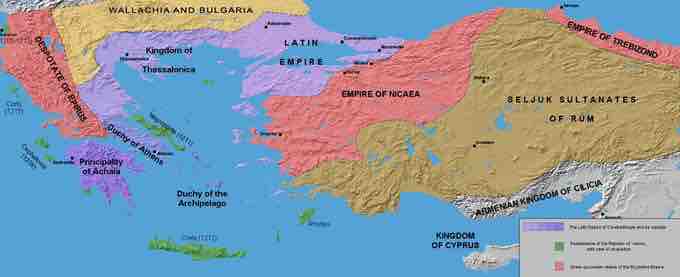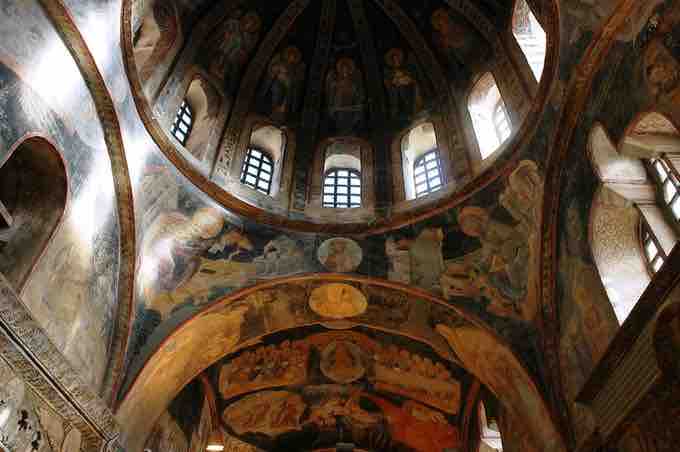The period of Late Byzantium saw the decline of the Byzantine Empire during the thirteenth through fifteenth centuries. Although the capital city of Constantinople and empire as a whole prospered as a connection between east and west traders, Byzantium continually dealt with threats from the Ottoman Turks to the east and the Latin Empire to the west. During the Fourth Crusades, the Crusaders attacked Constantinople, took the city under siege in 1203, and eventually overcame the defenses to sack the city in 1204. Constantinople became the capital city of the Latin Empire, one of the new kingdoms of divided Byzantium, until the Byzantines retook it in 1261. Once more, Constantinople became a prosperous Byzantine city until falling to the Ottoman Turks in 1453. The sack of Constantinople in 1204 marks the starting point of Late Byzantine Art, which lasted until the fifteenth century and spread beyond the borders of Byzantium.

The Division of the Byzantine Empire after its Sacking in 1204
The division of the Byzantine Empire after its sacking in 1204 by French and Italian armies during the Fourth Crusades
Art during this period began to change from the standards and styles seen in the Early and Middle periods of Byzantium rule. A renewed interest in landscape and earthly settings arose in mosaics, frescoes, and psalters. This development eventually led to the demise of the gold background. The settings are often simple, perhaps a hill or a chair at first, and are often pastoral. Architecture began to be depicted more often, which renewed the use of perspective. At first buildings were rendered slightly skewed, but eventually artists refined the combination of material (mosaic and painting) with architecture and perspective .

Christ Healing a Paralytic
Mosaic in Caphernaum from cycle of the Life of Christ. Outer narthex, Chora Church, Constantinople. c. 1310-20.
Mosaic work was still popular in the Late Byzantine period, but frescoes and the depiction of narrative cycles began to increase in popularity to become the primary decoration in churches. This transition is seen in the Chora Church, which was initially decorated in mosaic, with the final wing decorated with wall paintings. The shift in media changed the subjects depicted. Mosaics of single scenes and figures were replaced in favor of frescoed narrative cycles and biblical stories. The rendering of the figures also began to change. Artists now relied less on sharp, schematic folds and patterns and instead use softer, more subtle modeling and shading. While sharp folds in the drapery can still be found in images from this period, these folds are rendered in similar, not complimentary, colors and shades. Furthermore the bodies appear to have mass and weight. The figures no longer float or hover on their toes but stand on their feet. This allows for the addition of movement and energy in the painted figures and overall increase of drama and emotion.

Frescoed Interior of the Paracclesion Fresco
Scenes from the lives of the Virgin Mary and Christ. Chora Church, Constantinople. c. 1310-20.
Although sculpture and column design are largely absent from discussions of Late Byzantine art, some notable fourteenth-century examples can be found in the Pammakaristos Church in Constantinople. Although the church was converted to a mosque in the fifteenth century, and all representations of humans and animals were either destroyed or covered, at least two fragments of a column capital depicting the busts of apostles in high relief survives in the collection. While the heads of the men are somewhat large in proportion to their bodies, their bodies have assumed more naturalistic positions than their predecessors. They direct their gazes to either subtle or sharp angles. The two hands that are visible hold books, possibly the Gospels, to their chests. In sum, their poses anticipate the return to classicism that would define the Renaissance in the West.
Column capital decorated with busts of apostles.
Marble, Pammakaristos Church excavations. Early 14th century.